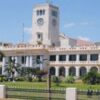West Bengal: Unchecked decline
A century ago the eastern seaboard state of West Bengal (pop. 91 million) was the epicentre of India’s intellectual and cultural renaissance under great scholars such as Raja Ram Mohan Roy, Dwarkanath and Rabindranath Tagore. But since then, the state’s intellectual tradition has been reduced to a sorry condition following the 34 years (1977-2011) rule of the Communist Party of India-Marxist in West Bengal.
This is confirmed by the Education Development Index (EDI) 2010-11 compiled by the Delhi-based National University for Educational Planning and Administration (NUEPA) released in Delhi in early September. With a literacy percentage of 77.1, West Bengal is ranked 27 among the country’s 28 states and seven Union territories in EDI 2010-11. The Union territory of Puducherry tops the composite (primary and upper primary) EDI 2010-11. Only seven states — Odisha (28), Uttar Pradesh (29), Meghalaya (30), Madhya Pradesh (32), Assam (33), Jharkhand (34), and Bihar (35) — are ranked below West Bengal which right until the 1960s was in the education (and industrial) vanguard of the nation.
Detailed data provided by the District Information System on Education (DISE) of the Union HRD ministry in the DISE Flash Statistics 2010-2011: Elementary Education in India high-light how far elementary (classes I-VIII) standards in West Bengal have plunged during the 34-year-rule of the Left Front government. Although gross enrolment in primary school is 136.86 percent, well above the national average of 118.62 percent, in upper primary schools it drops to 92.43 percent and only 67.72 percent of children complete upper primary (class VIII) education.
According to DISE Flash Statistics 2010-11, with 75,141 primary schools staffed by 25,000 teachers, West Bengal is one of the country’s most laggard large states for provision of primary education with a teacher-pupil ratio of 1:32 in elementary education (class I-VIII) against the national average of 1:29. Moreover, CRY (Child Relief and You) statistics indicate that the average primary school attendance in West Bengal is 65.9 percent against the national average of 74.2 percent, with 20.6 percent of schools in Bengal recording less than 50 percent attendance per day.
 EDI 2010-11 mercilessly exposes that primary education in West Bengal had been cruelly neglected by the Left Front for over three decades. Over 10 million children are cramped into poorly ventilated and hot classrooms in primaries lacking kitchen and storage facilities or designated spaces for mid-day meals. According to state government sources, 3.2 million children in the five-13 age group are out of school in West Bengal which hosts a mere 8,708 private schools cf. 28,253 in Maharashtra (pop. 112 million) and 12,093 in Karnataka (pop. 61 million).
EDI 2010-11 mercilessly exposes that primary education in West Bengal had been cruelly neglected by the Left Front for over three decades. Over 10 million children are cramped into poorly ventilated and hot classrooms in primaries lacking kitchen and storage facilities or designated spaces for mid-day meals. According to state government sources, 3.2 million children in the five-13 age group are out of school in West Bengal which hosts a mere 8,708 private schools cf. 28,253 in Maharashtra (pop. 112 million) and 12,093 in Karnataka (pop. 61 million).
“For all their faults — authoritarianism, corruption, nepotism and indifference to public opinion — communist governments in the former Soviet Union, China, Cuba and even in Kerala, accorded prime importance to primary education and eradication of illiteracy. The CPM-led Left Front of West Bengal is perhaps the only exception to this rule. During its 34 year reign, it ruined not only primary but secondary and higher education institutions in the state by packing them with its quasi-literate cadres and suppressing genuine intellectuals. Under Left Front rule West Bengal experienced a prolonged Mao-style Cultural Revolution,” says an eminent and embittered academic, who preferred to remain anonymous.
Nor is the situation improving under the Trinamool Congress which replaced the Left Front government in Writers Building, Kolkata in May 2011. According to Sunanda Sanyal, former professor of English at Calcutta University, for “mysterious reasons” the Left Front government accorded rock-bottom priority to primary education. “Moreover it banned English language learning in primary and upper education which adversely affected secondary and higher education standards. Unfortunately the Trinamool government is following the same path and is mindlessly politicising the education system. Ill-conceived policies introduced by the new government such as automatic promotions until class VIII will aggravate the already abject situation as children will not take school education seriously,” he says.
With the Trinamool Congress government led by its authoritarian chief minister Mamata Banerjee continuing to pursue the Left Front government’s education policies by other means, the long night of the cruelly neglected children of West Bengal is not over.
Baishali Mukherjee (Kolkata)
















Add comment